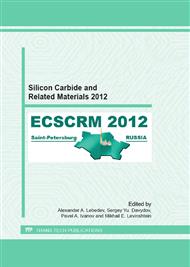[1]
A. Qteish, V. Heine, R.J. Needs, Phys. Rev. B 45 (1992) 6534.
Google Scholar
[2]
K.M. Speer, D.J. Spry, A.J. Trunek, P.G. Neudeck, M.A. Crimp, J.T. Hile, C. Burda, P. Pirouz, Mat. Sci. Forum 556-557 (2007) 223.
DOI: 10.4028/www.scientific.net/msf.556-557.223
Google Scholar
[3]
S.E. Saddow, C.L. Frewin, C. Coletti, N. Schettini, E. Weeber, A. Oliveros, M. Jarosezski, Mater. Sci. Forum 679-680 (2011) 824.
DOI: 10.4028/www.scientific.net/msf.679-680.824
Google Scholar
[4]
A.A. Lebedev, Semicond. Sci. Technol. 21 (2006) R17.
Google Scholar
[5]
H. Nagasawa, K. Yagi, T. Kawahara, N. Hatta, Chem. Vap. Deposition 12 (2006) 502-508.
DOI: 10.1002/cvde.200506466
Google Scholar
[6]
D. Chaussende, J. Eid, F. Mercier, R. Madar, M. Pons, Mater. Sci. Forum 615-617 (2009) 31-36.
DOI: 10.4028/www.scientific.net/msf.615-617.31
Google Scholar
[7]
M. Soueidan, G. Ferro, Adv. Funct. Mater. 16 (2006) 975-979.
Google Scholar
[8]
R. Vasiliauskas, M. Marinova, M. Syväjärvi, R. Liljedahl, G. Zoulis, J. Lorenzzi, G. Ferro, S. Juillaguet, J. Camassel, E.K. Polychroniadis, R. Yakimova J. Cryst. Growth 324 (2011) 7–14.
DOI: 10.1016/j.jcrysgro.2011.03.024
Google Scholar
[9]
K. Seki, Alexander; S. Kozawa, T. Ujihara, P. Chaudouet, D. Chaussende, Y. Takeda, J. Cryst. Growth 335 (2011) 94.
Google Scholar
[10]
T. Kimoto, A. Itoh, H. Matsunami, Appl. Phys. Lett. 66 (1995) 3645.
Google Scholar
[11]
R. Vasiliauskas, M. Marinova, P. Hens, P. Wellmann, M. Syväjärvi, R. Yakimova Cryst. Growth Des., 12 (2012) 197−204.
DOI: 10.1021/cg200929r
Google Scholar
[12]
R. Vasiliauskas, S. Juillaguet, M. Syväjävi and R. Yakimova, J. Cryst. Growth, 348 (2012) 91–6.
Google Scholar
[13]
R. Vasiliauskas, A. Mekys, P. Malinovskis, S. Juillaguet, M. Syväjävi, J. Storasta and R. Yakimova, J. Phys. D: Appl. Phys. 45 (2012) 225102.
DOI: 10.1088/0022-3727/45/22/225102
Google Scholar
[14]
J. Lu, M.V.S. Chandrashekhar, J.J. Parks, D.C. Ralph and M.G. Spencer, Appl. Phys. Lett. 94 (2009) 162115.
Google Scholar
[15]
R. Vasiliauskas, A. Mekys, P. Malinovskis, M. Syväjärvi, J. Storasta, R. Yakimova, Mater. Lett. 74 (2012) 203–205.
DOI: 10.1016/j.matlet.2012.01.120
Google Scholar
[16]
A.A. Lebedev, P.L. Abramov, S.P. Lebedev, G.A. Oganesyan, A.S. Tregubova, D.V. Shamshur, Phys. B 404 (2009) 4758-60
Google Scholar


